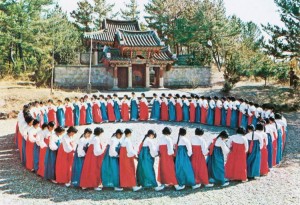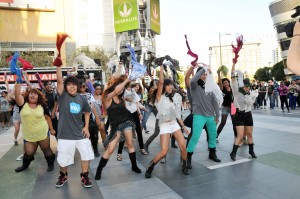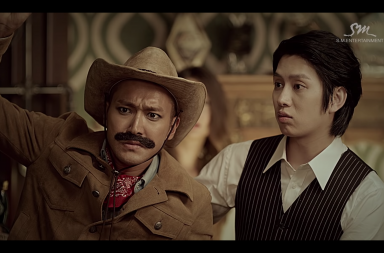2Yoon’s “24/7”, an indie-inspired take on American country represents a huge musical departure for members of hip-hop group 4Minute. However, despite mixed critical response, the video and the song commit fully to expressing the country-pop essence. In addition to more overt homage with prairie dresses, banjos and swinging saloon doors, “24/7” also subtly captures the anima of country with lyrical motifs and narrative structure. Perhaps the most striking feature of the song, however, is the creation of a set of dance moves to accompany the chorus. Song-specific dances are a key characteristic of both American country-western and K-pop, from the The Wonder Girl’s “Tell Me” dance to Billy Ray Cyrus’ “Achy Breaky Heart”. A YouTube search reveals that “24/7” has been successful in their creation of a new dance craze, with almost 100 dance covers already existing despite the video being just over a week old. Both K-pop and country music use social dance to allows connections and foster a sense of community essential to the success of both genres.
Social dancing is culturally variable, making a strict definition hard to pin down. However, social dancing at heart fills the divide between the chaos of the club or mosh pit and the rigid structure of theatrical performance. Frequently, these dances requires knowledge of particular steps, but no prior arrangement of complex formations or coordination with other performers. Crucially, participation must be attainable with minimal skill or training, though mastery might take a lifetime. Much like singing and chanting, social dancing releases oxytocin that are associated with the formation of social bonds. Also, it stimulates interaction and socialization in what might otherwise be awkward contexts. Thus, anthropologically, social dance serves multiple functions: strengthening social bonds within a community, allowing cross-demographic socialization, and rigidly defining community membership through evaluation of dance familiarity.
Korea and the US share a rich dance history. However, while dances associated with theatrical performance and kisaeng entertaining have a long history in Korea, the emergence of true social dance is a recent phenomenon. The history of coupled dancing is virtually non-existent, and folk dancing, while present, rarely dominated social gatherings. One notable exception is the 5000-year old Ganggangsullae, a nighttime harvest dance performed by village women that has recently become canonized as essential Korean culture.  While Korean folk dancing largely served direct ritual purpose, the function of social dancing in the US was frequently the basis of social interaction, especially dating. In the US, these folk dances included square dance and contra dance, both widespread cultural traditions before the 20th century. US and Korean cultures collided after World War II, as ballroom and square dancing spread rapidly through Korea as part of the Western cultural package. Despite repeated backlashes against Westernized dancing, both traditions remain a important part of socialization rituals in Korea, particularly among urban senior citizens.
While Korean folk dancing largely served direct ritual purpose, the function of social dancing in the US was frequently the basis of social interaction, especially dating. In the US, these folk dances included square dance and contra dance, both widespread cultural traditions before the 20th century. US and Korean cultures collided after World War II, as ballroom and square dancing spread rapidly through Korea as part of the Western cultural package. Despite repeated backlashes against Westernized dancing, both traditions remain a important part of socialization rituals in Korea, particularly among urban senior citizens.
While social dancing in both countries before 1960 was a performance of local traditions and regional identity, the rise of mass-produced music thoroughly revolutionized the scale across which people can connect. American record producers co-opted the social functions of dance during the country rock boom of the 1970s. Now, song-specific dance served as a way to connect to other fans and the artists themselves. Each song has a particular dance associated with it, typically self-organized into a line. More recently, K-pop has thoroughly embraced the line dance tradition using YouTube and social media as a means of transmission. From T-ara’s “Roly Poly” to Super Junior’s “Sorry, Sorry,” learning K-pop dances has become a popular pastime across urban and rural demographics. As we’ve already covered, the allure of K-pop dance covers have led to the formation of both performance groups and international dance competitions. But these dances are also performed in night clubs and bars across the country, similar to “Teach Me How to Dougie” or “The Electric Slide”. K-pop dance covers facilitate social and group connection, even beyond the boundaries of YouTube. Ironically, while many of these campaigns have been top-down, some of the most successful dance crazes haven’t been started by the artists themselves. Here the artists themselves become secondary to the community itself, swept along under a tidal wave of grassroots enthusiasm that has been mobilized under the artist’s song.
Thus, while social dance may have emerged in different contexts in K-pop and American country, ultimately the desire for connection is the same. This is in contrast to Western pop songs, who rarely create song-specific dances and who use distance from fans to create an separatist allure. Other song components, prominently featured both in “24/7” and in country music also drive the connection between fans and artists. “24/7” thematically matches some of the biggest country dance hits, most notably “Some Day you Gotta Dance” by the Dixie Chicks, by detailing hardships suffered by the members before reaching a swelling chorus that suggests an easily-attainable solution. Country music rarely suggests people improve their lives with massive changes, and instead aims to take people as they are. Similarly, the flash-mob style of the dance in the video encourages joining in whenever one is able. It’s all designed to foster group participation, regardless of skill level, to connect within a broader community.
With “24/7” 2Yoon have captured the essence that unites K-pop with American country music: a sense of acceptance, the urge to dance, and the yearning for connection outside of oneself.
(Dunbar(2010), country-time.com, historyofcountrymusic.com, billboard.com,omarnasia.blogspot.com Van Zile (2001), I-Hwa (2001), blog.viki.com, kpop-dance-music.blogspot.com, marsashabrina.wordpress.com)



